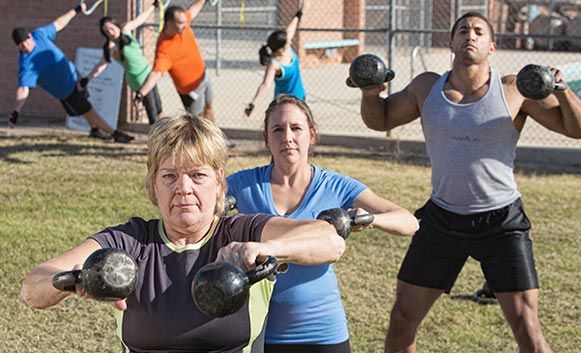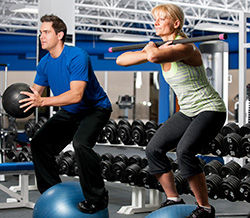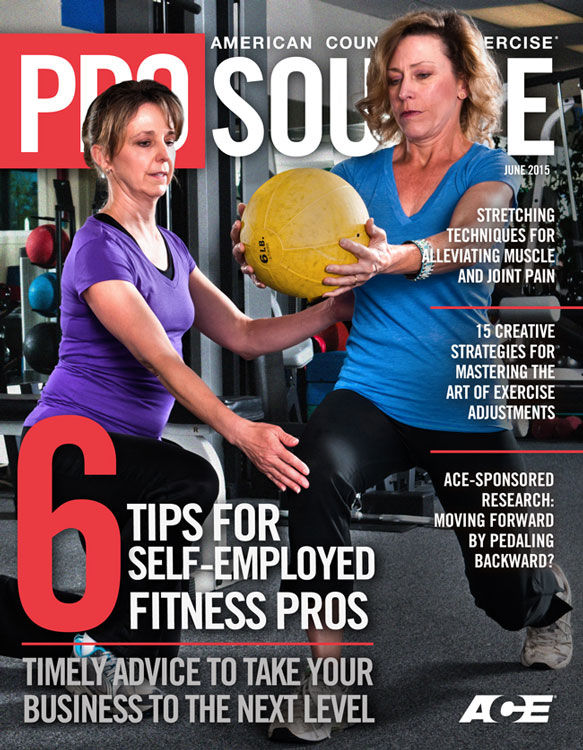
As group personal-training modalities grow in popularity, trainers are frequently faced with the prospect of coaching clients with vastly different abilities at the same time. That’s why, more than ever, trainers—and especially those who coach small- or large-group training sessions, or boot camps—must become masters at cueing progressions and regressions quickly and efficiently. Here’s how to master the art of creative exercise adjustments.

Avoiding Over-progressing
In an effort to “wow” clients, a novice trainer might be drawn to adjusting too many variables, too quickly. Giving in to the temptation to create flashy yet unsafe moves is even more problematic (having a deconditioned client do a one-armed overhead snatch with a weighted vest while blindfolded on a BOSU…not good).
“I often think that many trainers believe that they need to create ‘unseen’ exercises, so they go a little overboard in building progressions,” says industry veteran Hayley Hollander.
“Great trainers know exactly what their clients can and cannot do and they never give them more than what they know they can handle,” agrees Ness-Sonnemaker.
You’ll know someone is ready to progress based on his or her ability to perform an exercise with good technique, says Ness-Sonnemaker. “If a client is not able to perform the exercise properly, whether due to fatigue or the intensity of the exercise, the exercise should not be progressed.” Other red flags are pain during and after exercise, and whether or not the client can achieve the desired repetition range, she adds.
Adjusting Intelligently
Regressions make an exercise easier to perform, and progressions make it harder. But before adjusting any move, you’ll need a logical plan of attack.
First, assess function: Particularly when working with multiple clients (as when training small groups), you’ll need a screening process that assesses individual clients’ fitness levels, says Rick Mayo, the CEO of Alloy Personal Training Solutions and owner of North Point Fitness in Atlanta, Ga. “We use a ‘friendly’ version of the Functional Movement Screen [FMS] married to a client’s health history to determine his or her level (think beginner, intermediate and advanced).”
Pre-plan progressions: It’s important to have a list of adjustments for each exercise you have programmed into your clients’ workouts, says Steve Long, the owner of Complete Fitness Results, a training studio in St Louis, Mo., and the co-creator of branded exercise program Smart Group Training. In multitrainer businesses, be sure to discuss acceptable adjustments during staff meetings, so everyone is on the same page, he adds. Make it a goal to learn at least two regressions and progressions for every exercise you instruct.
Systematize group cueing: When training larger groups (eight to 20 clients), it can be challenging to cue regressions on the fly. Long’s solution is a system he calls “Smart Group Training.”
At his facility, all incoming clients go through the FMS, either one-on-one or in a group. Based on their results, clients are assigned colored wrist bands based on any dysfunctional patterns that appear. For example, a client who scores a one (the lowest score) on the active straight-leg raise (a test that measures lower-body mobility and function) might receive a yellow bracelet. In a group-training session, the instructor could then easily see who needed to regress hip-dominant exercises (such as a deadlift). Different colors are used for each of the FMS’ seven movement screens, so a client may wear several bracelets of different colors at any one time, with each relating to the restriction of a specific movement pattern.
“That way the coaches know what movement a client should and shouldn’t do just by looking at the client’s wrist,” says Long.
Coordinate your coaches: If you operate a group-training business in which trainers share clients, you’ll need a standard process of operation that ensures all instructors stay on the same page about which clients receive regressions or progressions, says Hayley Hollander, the Fitness Director of the Midtown Athletic Club Chicago and a PTA Global Faculty Member who is based in Chicago, Ill.
Client fitness could be assessed at customer intake and then coded into a grid or numerical value, Hollander says. (Hollander likes the PTA Global Design Questionnaire for this purpose). Injuries, she says, also should be communicated via some sort of roster. That way, the acute variables of the workout can be manipulated to match to everyone’s individual intensity, even while exercising in a group setting.
Mayo says that a custom mobile app or a combination of Word documents, spreadsheets and written notes can also be used to communicate individual client needs to coaches.
Coach compassionately: How can a trainer best coach a client to regress when necessary, without making him or her feel incompetent or incapable? A good rule of thumb is to give the entire group the lower level of progressions, and then cue progressions on an individual basis, says Long.
Also note that regressions—even though they may seem easy to you—should still feel challenging to the client, says Valorie Ness-Sonnemaker, an award-winning personal trainer and the CEO of Catalyst Fitness in Atlanta, Ga. “Just because an exercise is ‘regressed’ does not mean that the overall intensity or feel of the exercise should be any less than [those associated with] a progression,” she says. “Regressions can still be made to be challenging. Thus the client feels successful because they complete the exercise as it was intended.”
Adjusting Acute Variables
Safety, risk-to-reward ratios and your client’s unique goals are critical to keep in mind before progressing any exercise. Thus the following list is meant to be exhaustive in scope, but not in application (see the sidebar, Avoiding Over-progressing).
The most important acute variable that may be adjusted is exercise selection, followed by exercise sequence (order) and intensity, notes Ness-Sonnemaker. “After the first three, the others can come in any order as they all become interdependent on each other.”
This also means that some factors overlap. “For example, range of motion and length of lever arm are dependent on each other, in that range of motion will decrease as the length of the lever arm increases, and vice versa,” explains Ness-Sonnemaker.
Here are some creative ways to tweak classic exercises.
1. Increase/decrease training volume: This includes adjusting the numbers of sets and/or reps.
2. Increase/decrease rest between sets: Reducing the amount of rest between sets enhances the cardio challenge, while increasing rest time allows for greater recovery between sets.
3. Increase/decrease time under tension: This means changing tempo or speed of movement, as when performing fast reps versus super-slow reps.
4. Alter the load: Most simply, this means increasing or decreasing the amount of weight lifted. In bodyweight leverage training, load can be adjusted by changing the supporting limbs (e.g., a single-leg squat versus a traditional squat) or by adjusting lever length (see below).
5. Adjust the length of the lever arm: This adjustment moves the fixed point (fulcrum) of a movement further from the load. Examples include trying a push-up off of one’s knees rather than one’s toes, or performing a lateral dumbbell raise with bent arms instead of straight arms.
6. Alter range of motion: Change the “depth” of movement; for example, do a push-up only halfway (regression) rather than to the floor (progression).
7. Add plyometric elements: For example, add a jump to a squat.
8. Increase/decrease stability: This refers to performing moves on an unstable surface, often a type of ball, soft surface or wobble board.
9. Adjust the base of support: Stability can also be thought of in terms of stance—standing with wide feet versus with feet together versus supporting your weight on one foot. Changing your point-of-floor-contact positions may have sports-specific applications or be relevant to clients for whom stability is an issue of functionality (such as older seniors).
10. Add planes of motion: An example is adding a rotation at the top of the push-up. Consider the height of the movement, distance of the movement and direction of the movement, says Hollander. “Movement has this unlimited continuum when you look at it from a 360-degree approach, as well as in regards to our anatomy. The possibilities are infinite, and every individual’s [possibilities] are diverse.”
11. Increase/decrease the number of joints involved: A good example involves adding an overhead press to a traditional squat.
12. Segment the movement: If the client is not performing a movement properly, break it down into its component parts, says Ness-Sonnemaker. For example, an overheat snatch can be regressed to a deadlift; a forward lunge can be regressed to a stationary lunge or even a squat; and a heavily loaded bench press can be regressed to a push-up, she explains. Long refers to this as breaking down the movement, isolating the error and reintroducing segments back into larger patterns.
13. Introduce asymmetry: For example, try a one-armed cable row or a single-leg calf raise.
14. Add an unstable training tool: This introduces shifting resistance. Examples include slosh pipes, Kamagon balls and ActivMotion Bars.
15. Alter the breath: Try changing the breathing pattern during the movement, or cycle a breath at the end range to progress an exercise, says Long.
Combine several of the above elements at once: An example is a rotating push-up off of a BOSU ball with a weighted vest. But remember, while variety can add a fun factor, your clients’ safety, abilities and goals are your priorities. Complexity does not necessarily equal a better exercise and, at its worst, introduces unnecessary risk. Proceed with caution.
Other regressions/progressions include altering grip position, arm patterns, momentum (pausing mid-movement, for example), adding an element of uncertainty to an exercise (known versus unknown) and changing the application of load (point of contact with the body).
The Advantage of Adjustments
Strategic regressions and progressions should be the mainstay of the trainer’s toolkit. By not progressing clients too quickly, and by focusing on safety and intelligent programming, you can deliver variety and intensity to every client you instruct.





 by
by 



